Prioritization of Complex Health Issues
VerifiedAdded on 2023/06/09
|8
|2153
|318
AI Summary
This assignment discusses health related issues concerning Mr. Jim Cooper's first week of morning duties case study. The five main health issues concerning Mr. Jim Cooper includes, ineffective airwave clearance, impaired gas exchanger, risk for depression development, malnutrition as well as impaired physical mobility.
Contribute Materials
Your contribution can guide someone’s learning journey. Share your
documents today.
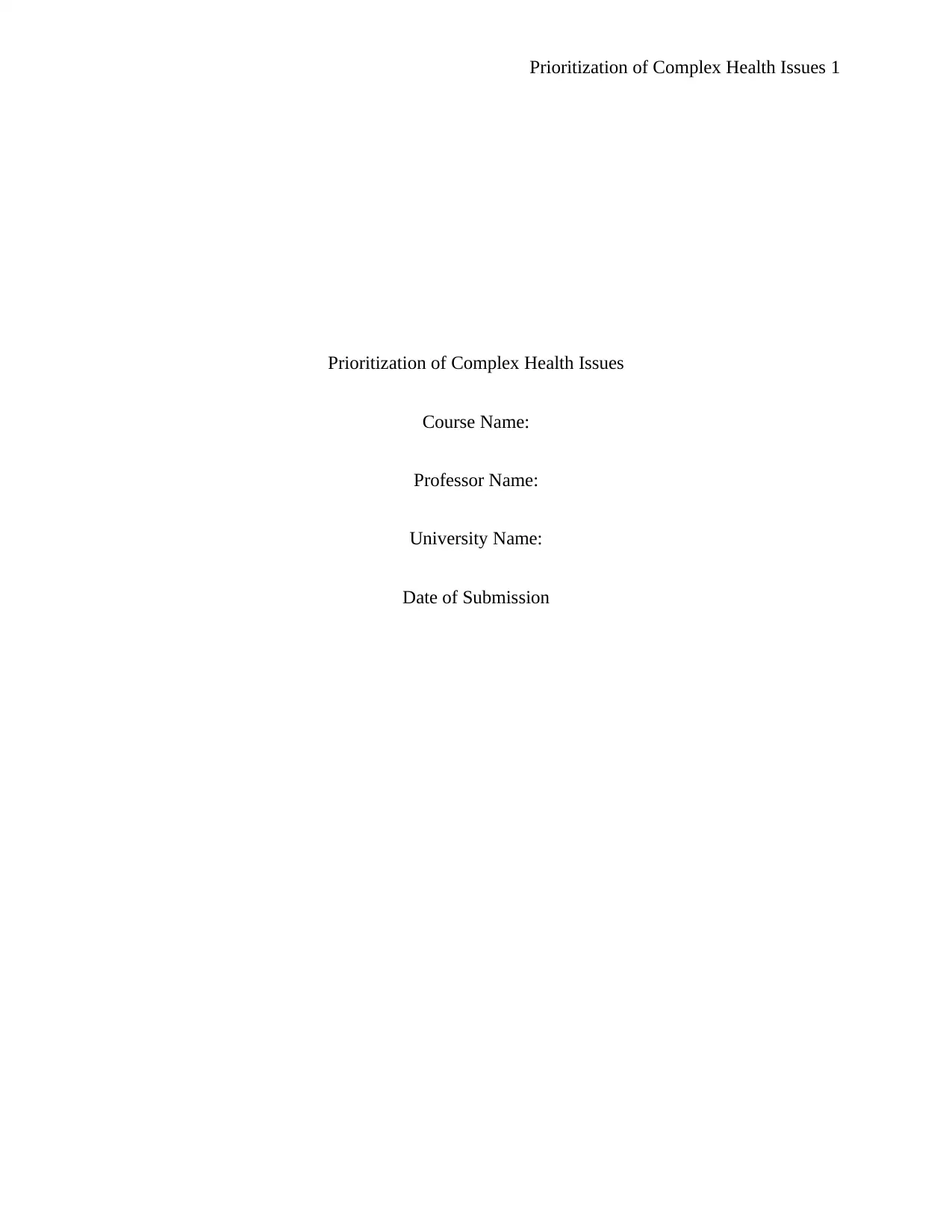
Prioritization of Complex Health Issues 1
Prioritization of Complex Health Issues
Course Name:
Professor Name:
University Name:
Date of Submission
Prioritization of Complex Health Issues
Course Name:
Professor Name:
University Name:
Date of Submission
Secure Best Marks with AI Grader
Need help grading? Try our AI Grader for instant feedback on your assignments.

Prioritization of Complex Health Issues 2
Part 1
The aim of this assignment is to find out and discus health related issues concerning Mr.
Jim Cooper first week of the morning duties case study. Jim Cooper who is 68 year-old male
patient was transferred from the emergency department to the respiratory medical unit as a result
of history of SOB and productive Cough that lasted for one week. Additionally, it is discovered
that Mr. Jim Cooper COPD was diagnosed with COPD 5 years ago and also
hypercholesterolemia. The five main health issues concerning Mr. Jim Cooper includes,
ineffective airwave clearance, impaired gas exchanger, risk for depression development,
malnutrition as well as impaired physical mobility.
There is total lack of priority for Malnutrition as well as impaired physical mobility.
Malnutrition is defined as the imbalance protein, energy and nutrients capable of causing severe
effects on human body associated with over or under nutrition (Banner et al., 2016). Concerning
Jim Cooper conditions, malnutrition is seen as under nutrition since he has a thin body with BMI
of 18.7kg/m2. Jim could suffer malnutrition because of COPD complication. Often, individual
suffering from COPD usually have symptoms of dyspnea as well as breathlessness capable of
causing insufficient oral intake and deprived appetite. Additionally, environment, psychological
and social factors also undermine nutritional intake. Since Jim retirement, he has been living
along because his wife died 18 months ago. He state that sometime he felt lonely that got him
down for the past few months thereby placing him at a high risk of malnutrition. Research
indicates that malnutrition enhances mortality, hospitalization as well as readmission; however, it
is capable of reducing muscle strength thus worsening the function of the respiratory muscle
(Simon et al., 2016). In Jim Cooper case, malnutrition is not life-threatening. Dietician can
manage and prevent through nutritional supplement prescription.
Part 1
The aim of this assignment is to find out and discus health related issues concerning Mr.
Jim Cooper first week of the morning duties case study. Jim Cooper who is 68 year-old male
patient was transferred from the emergency department to the respiratory medical unit as a result
of history of SOB and productive Cough that lasted for one week. Additionally, it is discovered
that Mr. Jim Cooper COPD was diagnosed with COPD 5 years ago and also
hypercholesterolemia. The five main health issues concerning Mr. Jim Cooper includes,
ineffective airwave clearance, impaired gas exchanger, risk for depression development,
malnutrition as well as impaired physical mobility.
There is total lack of priority for Malnutrition as well as impaired physical mobility.
Malnutrition is defined as the imbalance protein, energy and nutrients capable of causing severe
effects on human body associated with over or under nutrition (Banner et al., 2016). Concerning
Jim Cooper conditions, malnutrition is seen as under nutrition since he has a thin body with BMI
of 18.7kg/m2. Jim could suffer malnutrition because of COPD complication. Often, individual
suffering from COPD usually have symptoms of dyspnea as well as breathlessness capable of
causing insufficient oral intake and deprived appetite. Additionally, environment, psychological
and social factors also undermine nutritional intake. Since Jim retirement, he has been living
along because his wife died 18 months ago. He state that sometime he felt lonely that got him
down for the past few months thereby placing him at a high risk of malnutrition. Research
indicates that malnutrition enhances mortality, hospitalization as well as readmission; however, it
is capable of reducing muscle strength thus worsening the function of the respiratory muscle
(Simon et al., 2016). In Jim Cooper case, malnutrition is not life-threatening. Dietician can
manage and prevent through nutritional supplement prescription.
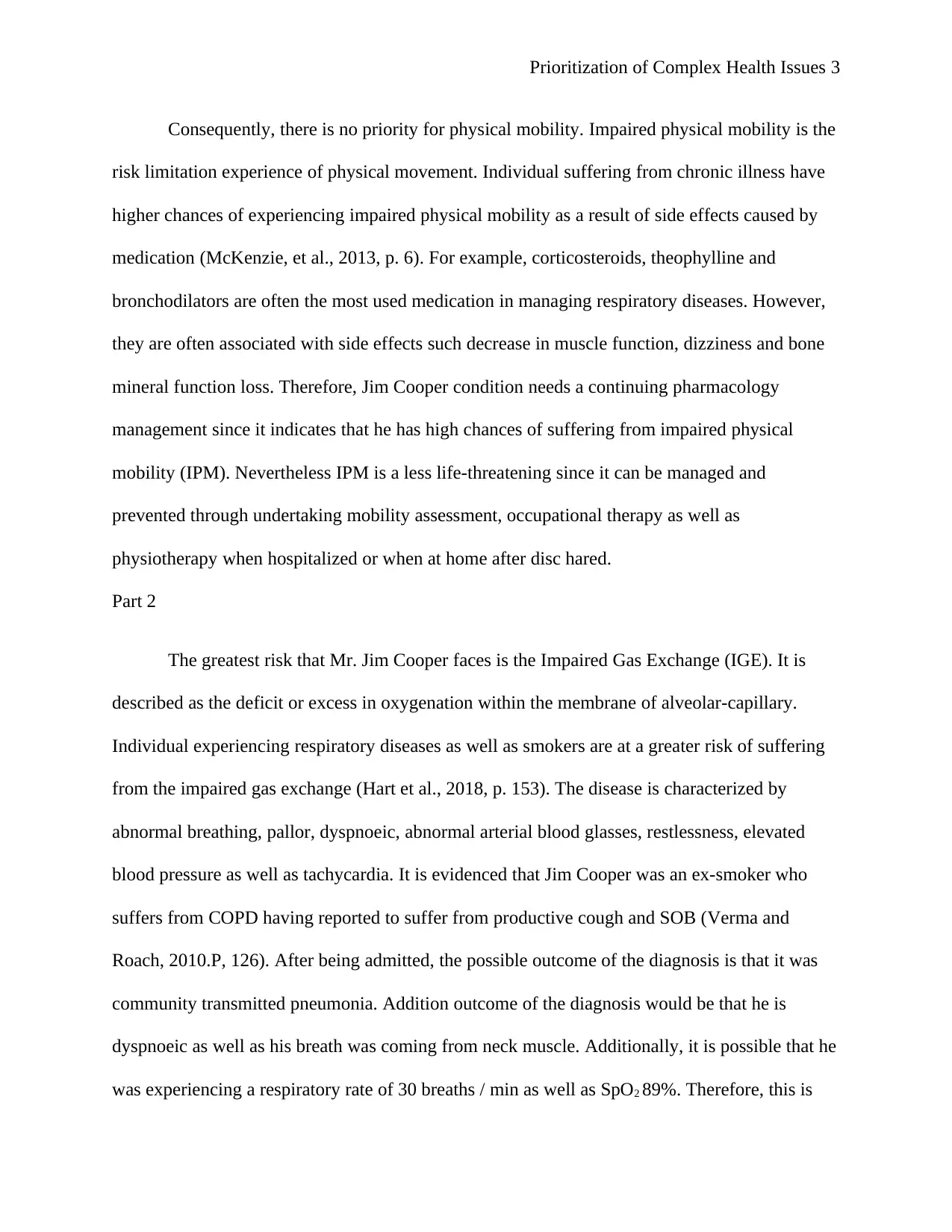
Prioritization of Complex Health Issues 3
Consequently, there is no priority for physical mobility. Impaired physical mobility is the
risk limitation experience of physical movement. Individual suffering from chronic illness have
higher chances of experiencing impaired physical mobility as a result of side effects caused by
medication (McKenzie, et al., 2013, p. 6). For example, corticosteroids, theophylline and
bronchodilators are often the most used medication in managing respiratory diseases. However,
they are often associated with side effects such decrease in muscle function, dizziness and bone
mineral function loss. Therefore, Jim Cooper condition needs a continuing pharmacology
management since it indicates that he has high chances of suffering from impaired physical
mobility (IPM). Nevertheless IPM is a less life-threatening since it can be managed and
prevented through undertaking mobility assessment, occupational therapy as well as
physiotherapy when hospitalized or when at home after disc hared.
Part 2
The greatest risk that Mr. Jim Cooper faces is the Impaired Gas Exchange (IGE). It is
described as the deficit or excess in oxygenation within the membrane of alveolar-capillary.
Individual experiencing respiratory diseases as well as smokers are at a greater risk of suffering
from the impaired gas exchange (Hart et al., 2018, p. 153). The disease is characterized by
abnormal breathing, pallor, dyspnoeic, abnormal arterial blood glasses, restlessness, elevated
blood pressure as well as tachycardia. It is evidenced that Jim Cooper was an ex-smoker who
suffers from COPD having reported to suffer from productive cough and SOB (Verma and
Roach, 2010.P, 126). After being admitted, the possible outcome of the diagnosis is that it was
community transmitted pneumonia. Addition outcome of the diagnosis would be that he is
dyspnoeic as well as his breath was coming from neck muscle. Additionally, it is possible that he
was experiencing a respiratory rate of 30 breaths / min as well as SpO2 89%. Therefore, this is
Consequently, there is no priority for physical mobility. Impaired physical mobility is the
risk limitation experience of physical movement. Individual suffering from chronic illness have
higher chances of experiencing impaired physical mobility as a result of side effects caused by
medication (McKenzie, et al., 2013, p. 6). For example, corticosteroids, theophylline and
bronchodilators are often the most used medication in managing respiratory diseases. However,
they are often associated with side effects such decrease in muscle function, dizziness and bone
mineral function loss. Therefore, Jim Cooper condition needs a continuing pharmacology
management since it indicates that he has high chances of suffering from impaired physical
mobility (IPM). Nevertheless IPM is a less life-threatening since it can be managed and
prevented through undertaking mobility assessment, occupational therapy as well as
physiotherapy when hospitalized or when at home after disc hared.
Part 2
The greatest risk that Mr. Jim Cooper faces is the Impaired Gas Exchange (IGE). It is
described as the deficit or excess in oxygenation within the membrane of alveolar-capillary.
Individual experiencing respiratory diseases as well as smokers are at a greater risk of suffering
from the impaired gas exchange (Hart et al., 2018, p. 153). The disease is characterized by
abnormal breathing, pallor, dyspnoeic, abnormal arterial blood glasses, restlessness, elevated
blood pressure as well as tachycardia. It is evidenced that Jim Cooper was an ex-smoker who
suffers from COPD having reported to suffer from productive cough and SOB (Verma and
Roach, 2010.P, 126). After being admitted, the possible outcome of the diagnosis is that it was
community transmitted pneumonia. Addition outcome of the diagnosis would be that he is
dyspnoeic as well as his breath was coming from neck muscle. Additionally, it is possible that he
was experiencing a respiratory rate of 30 breaths / min as well as SpO2 89%. Therefore, this is
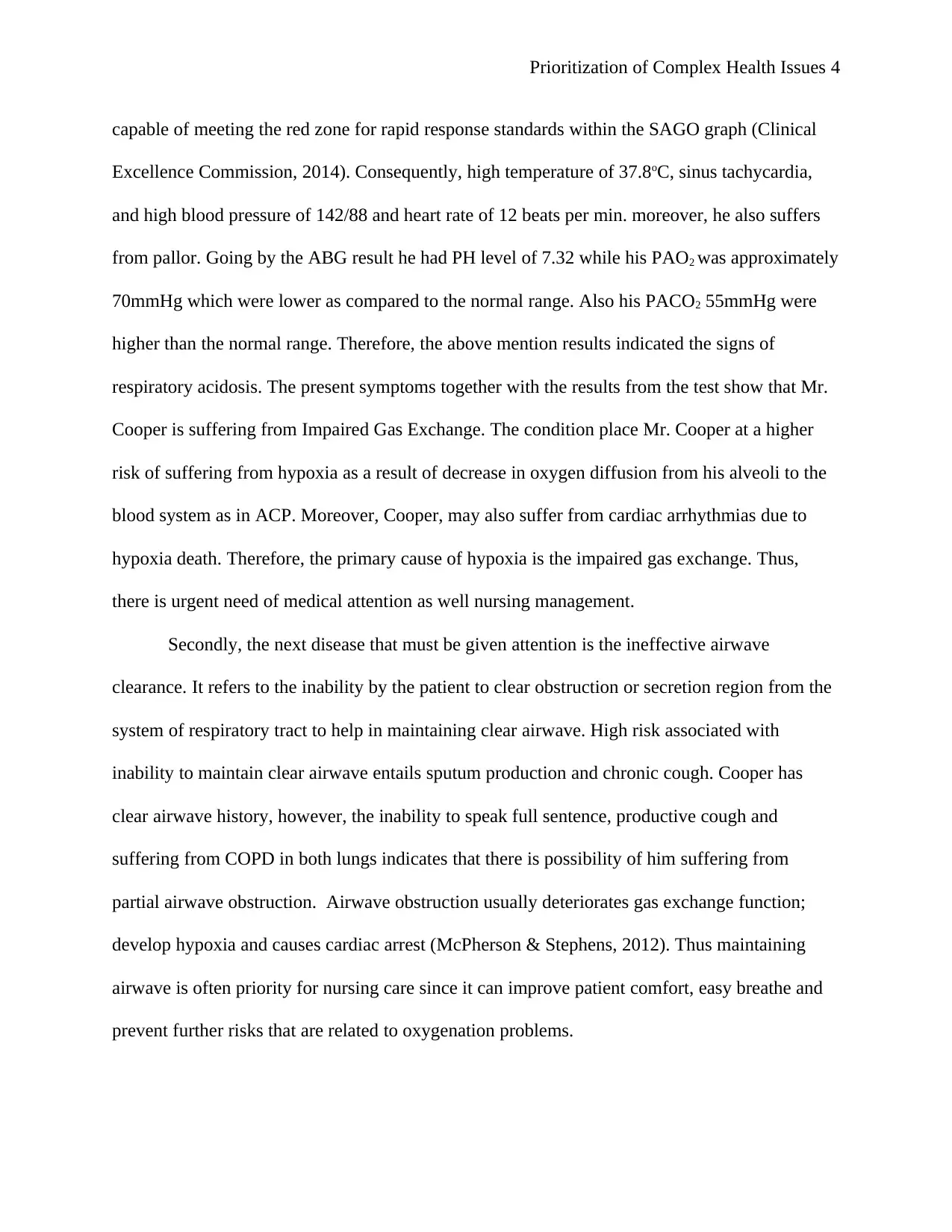
Prioritization of Complex Health Issues 4
capable of meeting the red zone for rapid response standards within the SAGO graph (Clinical
Excellence Commission, 2014). Consequently, high temperature of 37.8oC, sinus tachycardia,
and high blood pressure of 142/88 and heart rate of 12 beats per min. moreover, he also suffers
from pallor. Going by the ABG result he had PH level of 7.32 while his PAO2 was approximately
70mmHg which were lower as compared to the normal range. Also his PACO2 55mmHg were
higher than the normal range. Therefore, the above mention results indicated the signs of
respiratory acidosis. The present symptoms together with the results from the test show that Mr.
Cooper is suffering from Impaired Gas Exchange. The condition place Mr. Cooper at a higher
risk of suffering from hypoxia as a result of decrease in oxygen diffusion from his alveoli to the
blood system as in ACP. Moreover, Cooper, may also suffer from cardiac arrhythmias due to
hypoxia death. Therefore, the primary cause of hypoxia is the impaired gas exchange. Thus,
there is urgent need of medical attention as well nursing management.
Secondly, the next disease that must be given attention is the ineffective airwave
clearance. It refers to the inability by the patient to clear obstruction or secretion region from the
system of respiratory tract to help in maintaining clear airwave. High risk associated with
inability to maintain clear airwave entails sputum production and chronic cough. Cooper has
clear airwave history, however, the inability to speak full sentence, productive cough and
suffering from COPD in both lungs indicates that there is possibility of him suffering from
partial airwave obstruction. Airwave obstruction usually deteriorates gas exchange function;
develop hypoxia and causes cardiac arrest (McPherson & Stephens, 2012). Thus maintaining
airwave is often priority for nursing care since it can improve patient comfort, easy breathe and
prevent further risks that are related to oxygenation problems.
capable of meeting the red zone for rapid response standards within the SAGO graph (Clinical
Excellence Commission, 2014). Consequently, high temperature of 37.8oC, sinus tachycardia,
and high blood pressure of 142/88 and heart rate of 12 beats per min. moreover, he also suffers
from pallor. Going by the ABG result he had PH level of 7.32 while his PAO2 was approximately
70mmHg which were lower as compared to the normal range. Also his PACO2 55mmHg were
higher than the normal range. Therefore, the above mention results indicated the signs of
respiratory acidosis. The present symptoms together with the results from the test show that Mr.
Cooper is suffering from Impaired Gas Exchange. The condition place Mr. Cooper at a higher
risk of suffering from hypoxia as a result of decrease in oxygen diffusion from his alveoli to the
blood system as in ACP. Moreover, Cooper, may also suffer from cardiac arrhythmias due to
hypoxia death. Therefore, the primary cause of hypoxia is the impaired gas exchange. Thus,
there is urgent need of medical attention as well nursing management.
Secondly, the next disease that must be given attention is the ineffective airwave
clearance. It refers to the inability by the patient to clear obstruction or secretion region from the
system of respiratory tract to help in maintaining clear airwave. High risk associated with
inability to maintain clear airwave entails sputum production and chronic cough. Cooper has
clear airwave history, however, the inability to speak full sentence, productive cough and
suffering from COPD in both lungs indicates that there is possibility of him suffering from
partial airwave obstruction. Airwave obstruction usually deteriorates gas exchange function;
develop hypoxia and causes cardiac arrest (McPherson & Stephens, 2012). Thus maintaining
airwave is often priority for nursing care since it can improve patient comfort, easy breathe and
prevent further risks that are related to oxygenation problems.
Secure Best Marks with AI Grader
Need help grading? Try our AI Grader for instant feedback on your assignments.
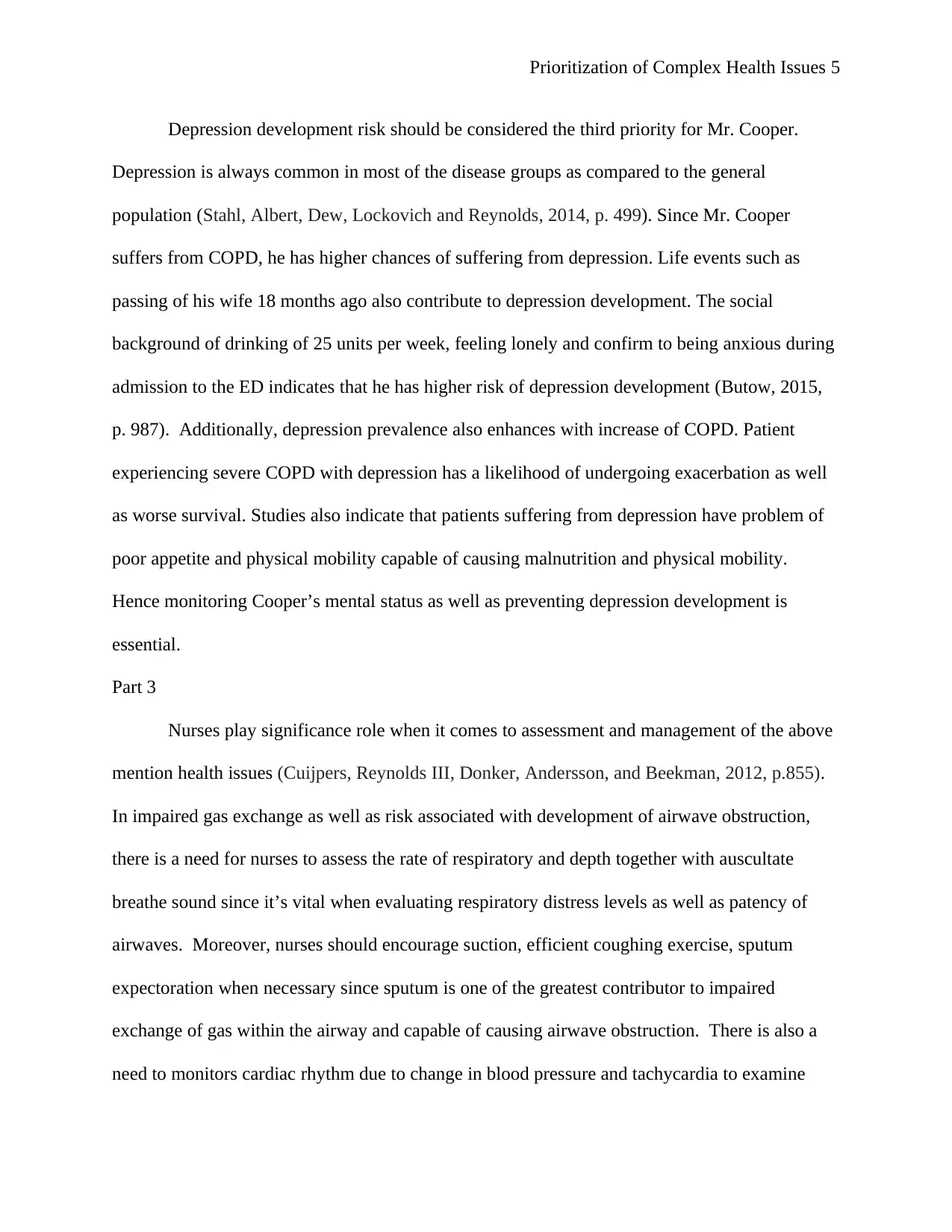
Prioritization of Complex Health Issues 5
Depression development risk should be considered the third priority for Mr. Cooper.
Depression is always common in most of the disease groups as compared to the general
population (Stahl, Albert, Dew, Lockovich and Reynolds, 2014, p. 499). Since Mr. Cooper
suffers from COPD, he has higher chances of suffering from depression. Life events such as
passing of his wife 18 months ago also contribute to depression development. The social
background of drinking of 25 units per week, feeling lonely and confirm to being anxious during
admission to the ED indicates that he has higher risk of depression development (Butow, 2015,
p. 987). Additionally, depression prevalence also enhances with increase of COPD. Patient
experiencing severe COPD with depression has a likelihood of undergoing exacerbation as well
as worse survival. Studies also indicate that patients suffering from depression have problem of
poor appetite and physical mobility capable of causing malnutrition and physical mobility.
Hence monitoring Cooper’s mental status as well as preventing depression development is
essential.
Part 3
Nurses play significance role when it comes to assessment and management of the above
mention health issues (Cuijpers, Reynolds III, Donker, Andersson, and Beekman, 2012, p.855).
In impaired gas exchange as well as risk associated with development of airwave obstruction,
there is a need for nurses to assess the rate of respiratory and depth together with auscultate
breathe sound since it’s vital when evaluating respiratory distress levels as well as patency of
airwaves. Moreover, nurses should encourage suction, efficient coughing exercise, sputum
expectoration when necessary since sputum is one of the greatest contributor to impaired
exchange of gas within the airway and capable of causing airwave obstruction. There is also a
need to monitors cardiac rhythm due to change in blood pressure and tachycardia to examine
Depression development risk should be considered the third priority for Mr. Cooper.
Depression is always common in most of the disease groups as compared to the general
population (Stahl, Albert, Dew, Lockovich and Reynolds, 2014, p. 499). Since Mr. Cooper
suffers from COPD, he has higher chances of suffering from depression. Life events such as
passing of his wife 18 months ago also contribute to depression development. The social
background of drinking of 25 units per week, feeling lonely and confirm to being anxious during
admission to the ED indicates that he has higher risk of depression development (Butow, 2015,
p. 987). Additionally, depression prevalence also enhances with increase of COPD. Patient
experiencing severe COPD with depression has a likelihood of undergoing exacerbation as well
as worse survival. Studies also indicate that patients suffering from depression have problem of
poor appetite and physical mobility capable of causing malnutrition and physical mobility.
Hence monitoring Cooper’s mental status as well as preventing depression development is
essential.
Part 3
Nurses play significance role when it comes to assessment and management of the above
mention health issues (Cuijpers, Reynolds III, Donker, Andersson, and Beekman, 2012, p.855).
In impaired gas exchange as well as risk associated with development of airwave obstruction,
there is a need for nurses to assess the rate of respiratory and depth together with auscultate
breathe sound since it’s vital when evaluating respiratory distress levels as well as patency of
airwaves. Moreover, nurses should encourage suction, efficient coughing exercise, sputum
expectoration when necessary since sputum is one of the greatest contributor to impaired
exchange of gas within the airway and capable of causing airwave obstruction. There is also a
need to monitors cardiac rhythm due to change in blood pressure and tachycardia to examine
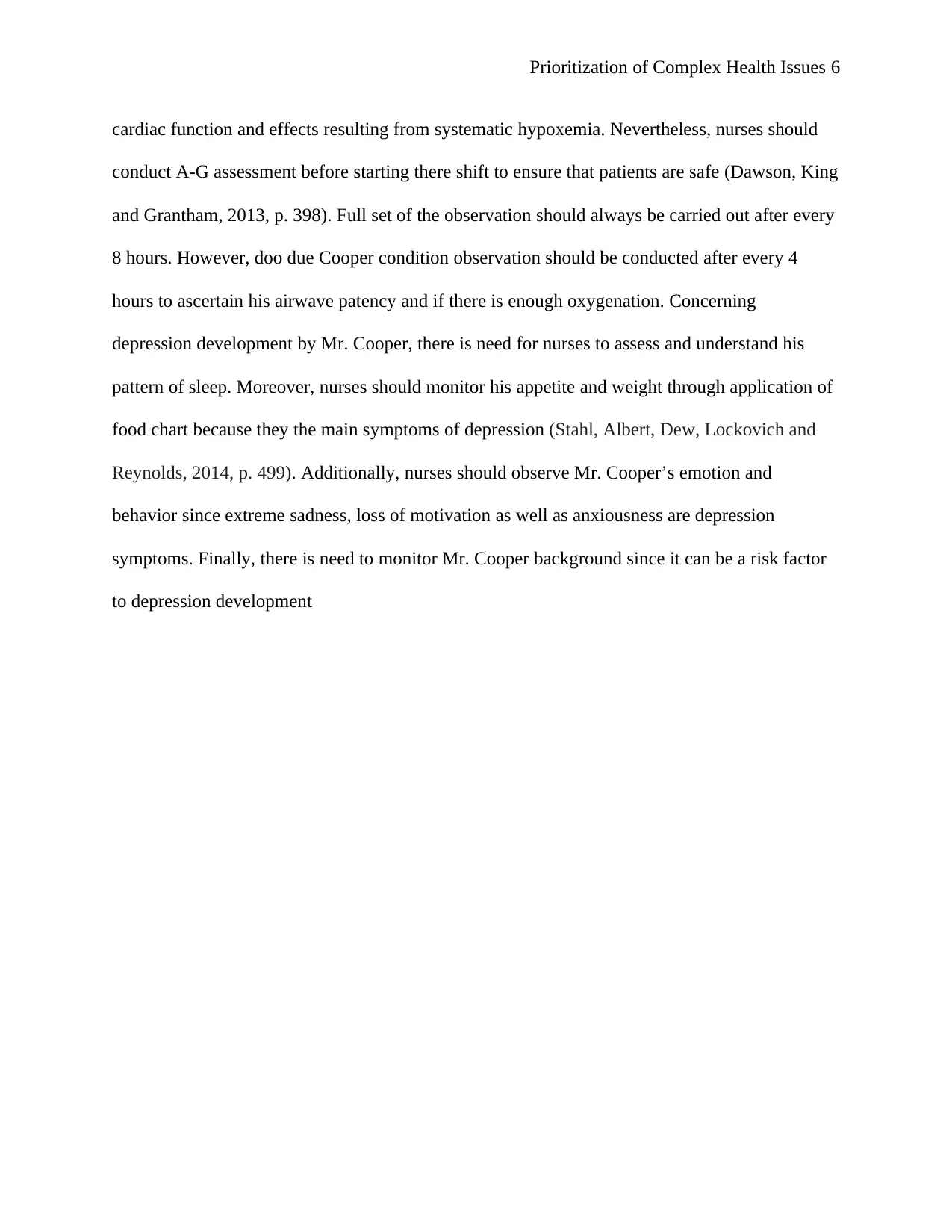
Prioritization of Complex Health Issues 6
cardiac function and effects resulting from systematic hypoxemia. Nevertheless, nurses should
conduct A-G assessment before starting there shift to ensure that patients are safe (Dawson, King
and Grantham, 2013, p. 398). Full set of the observation should always be carried out after every
8 hours. However, doo due Cooper condition observation should be conducted after every 4
hours to ascertain his airwave patency and if there is enough oxygenation. Concerning
depression development by Mr. Cooper, there is need for nurses to assess and understand his
pattern of sleep. Moreover, nurses should monitor his appetite and weight through application of
food chart because they the main symptoms of depression (Stahl, Albert, Dew, Lockovich and
Reynolds, 2014, p. 499). Additionally, nurses should observe Mr. Cooper’s emotion and
behavior since extreme sadness, loss of motivation as well as anxiousness are depression
symptoms. Finally, there is need to monitor Mr. Cooper background since it can be a risk factor
to depression development
cardiac function and effects resulting from systematic hypoxemia. Nevertheless, nurses should
conduct A-G assessment before starting there shift to ensure that patients are safe (Dawson, King
and Grantham, 2013, p. 398). Full set of the observation should always be carried out after every
8 hours. However, doo due Cooper condition observation should be conducted after every 4
hours to ascertain his airwave patency and if there is enough oxygenation. Concerning
depression development by Mr. Cooper, there is need for nurses to assess and understand his
pattern of sleep. Moreover, nurses should monitor his appetite and weight through application of
food chart because they the main symptoms of depression (Stahl, Albert, Dew, Lockovich and
Reynolds, 2014, p. 499). Additionally, nurses should observe Mr. Cooper’s emotion and
behavior since extreme sadness, loss of motivation as well as anxiousness are depression
symptoms. Finally, there is need to monitor Mr. Cooper background since it can be a risk factor
to depression development
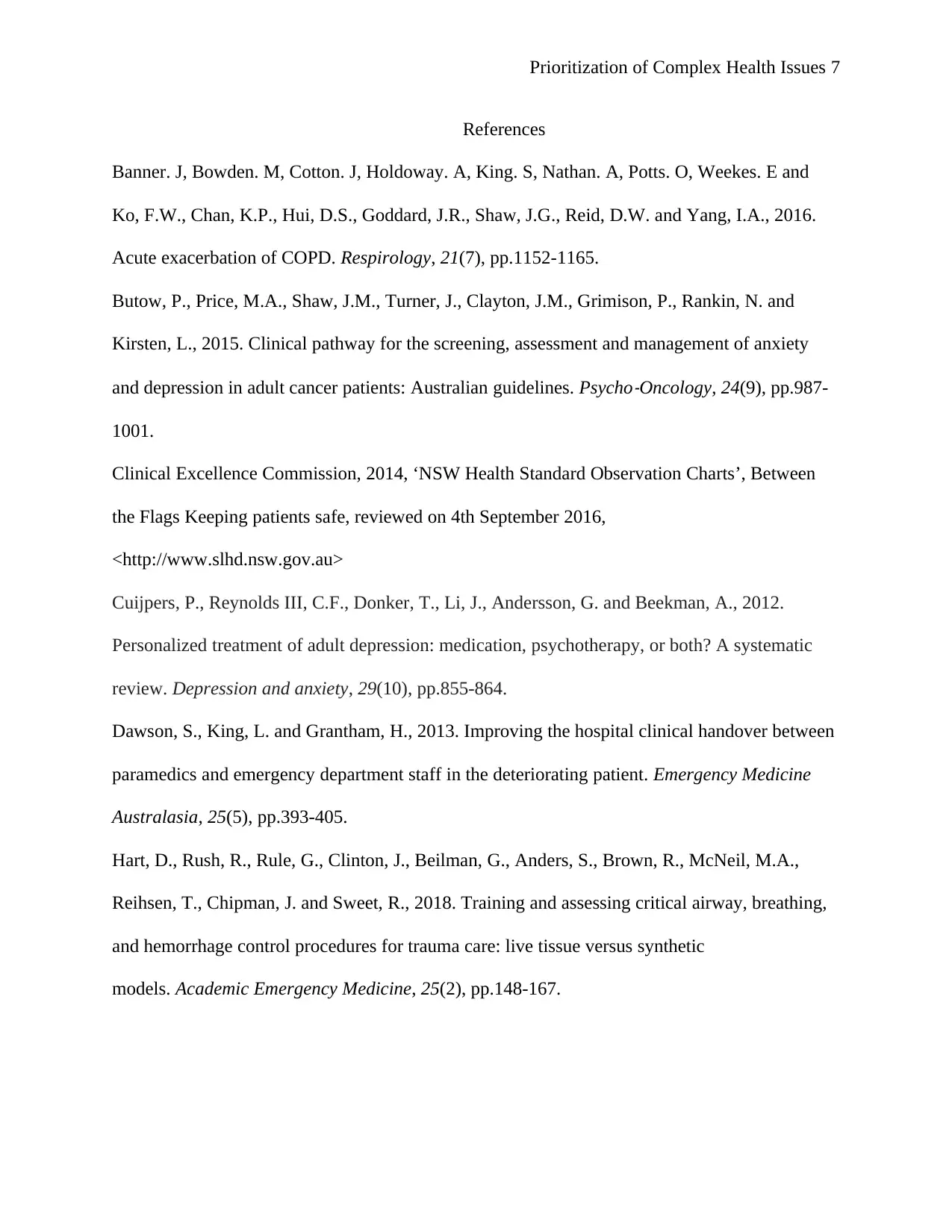
Prioritization of Complex Health Issues 7
References
Banner. J, Bowden. M, Cotton. J, Holdoway. A, King. S, Nathan. A, Potts. O, Weekes. E and
Ko, F.W., Chan, K.P., Hui, D.S., Goddard, J.R., Shaw, J.G., Reid, D.W. and Yang, I.A., 2016.
Acute exacerbation of COPD. Respirology, 21(7), pp.1152-1165.
Butow, P., Price, M.A., Shaw, J.M., Turner, J., Clayton, J.M., Grimison, P., Rankin, N. and
Kirsten, L., 2015. Clinical pathway for the screening, assessment and management of anxiety
and depression in adult cancer patients: Australian guidelines. Psycho
‐Oncology, 24(9), pp.987-
1001.
Clinical Excellence Commission, 2014, ‘NSW Health Standard Observation Charts’, Between
the Flags Keeping patients safe, reviewed on 4th September 2016,
<http://www.slhd.nsw.gov.au>
Cuijpers, P., Reynolds III, C.F., Donker, T., Li, J., Andersson, G. and Beekman, A., 2012.
Personalized treatment of adult depression: medication, psychotherapy, or both? A systematic
review. Depression and anxiety, 29(10), pp.855-864.
Dawson, S., King, L. and Grantham, H., 2013. Improving the hospital clinical handover between
paramedics and emergency department staff in the deteriorating patient. Emergency Medicine
Australasia, 25(5), pp.393-405.
Hart, D., Rush, R., Rule, G., Clinton, J., Beilman, G., Anders, S., Brown, R., McNeil, M.A.,
Reihsen, T., Chipman, J. and Sweet, R., 2018. Training and assessing critical airway, breathing,
and hemorrhage control procedures for trauma care: live tissue versus synthetic
models. Academic Emergency Medicine, 25(2), pp.148-167.
References
Banner. J, Bowden. M, Cotton. J, Holdoway. A, King. S, Nathan. A, Potts. O, Weekes. E and
Ko, F.W., Chan, K.P., Hui, D.S., Goddard, J.R., Shaw, J.G., Reid, D.W. and Yang, I.A., 2016.
Acute exacerbation of COPD. Respirology, 21(7), pp.1152-1165.
Butow, P., Price, M.A., Shaw, J.M., Turner, J., Clayton, J.M., Grimison, P., Rankin, N. and
Kirsten, L., 2015. Clinical pathway for the screening, assessment and management of anxiety
and depression in adult cancer patients: Australian guidelines. Psycho
‐Oncology, 24(9), pp.987-
1001.
Clinical Excellence Commission, 2014, ‘NSW Health Standard Observation Charts’, Between
the Flags Keeping patients safe, reviewed on 4th September 2016,
<http://www.slhd.nsw.gov.au>
Cuijpers, P., Reynolds III, C.F., Donker, T., Li, J., Andersson, G. and Beekman, A., 2012.
Personalized treatment of adult depression: medication, psychotherapy, or both? A systematic
review. Depression and anxiety, 29(10), pp.855-864.
Dawson, S., King, L. and Grantham, H., 2013. Improving the hospital clinical handover between
paramedics and emergency department staff in the deteriorating patient. Emergency Medicine
Australasia, 25(5), pp.393-405.
Hart, D., Rush, R., Rule, G., Clinton, J., Beilman, G., Anders, S., Brown, R., McNeil, M.A.,
Reihsen, T., Chipman, J. and Sweet, R., 2018. Training and assessing critical airway, breathing,
and hemorrhage control procedures for trauma care: live tissue versus synthetic
models. Academic Emergency Medicine, 25(2), pp.148-167.
Paraphrase This Document
Need a fresh take? Get an instant paraphrase of this document with our AI Paraphraser

Prioritization of Complex Health Issues 8
McKenzie, D.K., Abramson, M., Crockett, A.J., Glasgow, N., Jenkins, S. and McDonald, C.,
2013. The COPD-X Plan: Australian and New Zealand guidelines for the management of chronic
obstructive pulmonary disease 2009. Med J Aust, 178, p.6..
Simon, S.T., Higginson, I.J., Booth, S., Harding, R., Weingartner, V. and Bausewein, C., 2016.
Benzodiazepines for the relief of breathlessness in advanced malignant and non-malignant
diseases in adults. Cochrane Database Syst Rev, 10, p.CD007354.
Stahl, S.T., Albert, S.M., Dew, M.A., Lockovich, M.H. and Reynolds III, C.F., 2014. Coaching
in healthy dietary practices in at-risk older adults: a case of indicated depression
prevention. American Journal of Psychiatry, 171(5), pp.499-505.
Verma, A.K. and Roach, P., 2010. The interpretation of arterial blood gases. Aust Prescr, 33(4),
pp.124-129.
.
McKenzie, D.K., Abramson, M., Crockett, A.J., Glasgow, N., Jenkins, S. and McDonald, C.,
2013. The COPD-X Plan: Australian and New Zealand guidelines for the management of chronic
obstructive pulmonary disease 2009. Med J Aust, 178, p.6..
Simon, S.T., Higginson, I.J., Booth, S., Harding, R., Weingartner, V. and Bausewein, C., 2016.
Benzodiazepines for the relief of breathlessness in advanced malignant and non-malignant
diseases in adults. Cochrane Database Syst Rev, 10, p.CD007354.
Stahl, S.T., Albert, S.M., Dew, M.A., Lockovich, M.H. and Reynolds III, C.F., 2014. Coaching
in healthy dietary practices in at-risk older adults: a case of indicated depression
prevention. American Journal of Psychiatry, 171(5), pp.499-505.
Verma, A.K. and Roach, P., 2010. The interpretation of arterial blood gases. Aust Prescr, 33(4),
pp.124-129.
.
1 out of 8
Related Documents
Your All-in-One AI-Powered Toolkit for Academic Success.
+13062052269
info@desklib.com
Available 24*7 on WhatsApp / Email
![[object Object]](/_next/static/media/star-bottom.7253800d.svg)
Unlock your academic potential
© 2024 | Zucol Services PVT LTD | All rights reserved.




